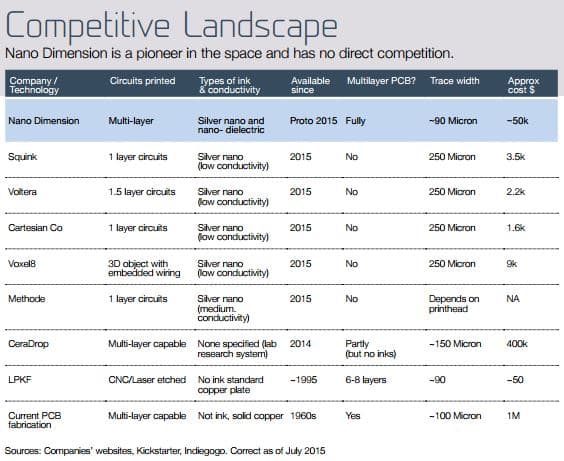A 3D Printed Electronics IPO from Nano Dimension

We’ve discussed before the differences between a machine that builds printed circuit boards (PCBs) and a machine that can create 3D printed electronics. 3D printed electronics could be considered a new technology while building PCBs is something companies have been doing for decades. Here’s what the competitive space looks like for printed electronics:
A company called Nano Dimension claims to be ahead of the pack, and was approved for a listing on the NASDAQ which for all practical purposes represents an IPO for U.S. based investors. We first wrote about Nano Dimension in November of 2015 when they announced pre-sales for their DragonFly 2020 3D Printer which can indeed print electronics in 3D.
Now bear in mind that this issue is a micro cap with just a $50 million capitalization at the moment. With the 3D printing market getting a serious nosebleed lately, this may be a 3D printing IPO that starts trading at a fair valuation unlike ExOne (NASDAQ:XONE) which is trading down -70% from their initial IPO price. Let’s take a closer look at the Nano Dimension regulatory filing which accompanied their application to be listed on NASDAQ under the symbol NNDM.
First thing we see is that this entity came to be traded via a reverse merger, the type of which we commonly see for OTC companies. A publicly traded “shell” acquires a private company and then they change the name to the private company. The end result is a private company which is publicly traded. Since that reverse merger, Nano Dimension has spent $7.3 million on developing their DragonFly 2020 3D Printer. In July of 2015, they began collaborations with several Fortune 100 and key Israeli companies for testing of the beta version of their 3D printer.
Also in the filing it’s mentioned that another 3D printing company called XJet has filed a $5.12 million lawsuit against Nano Dimension claiming that ex-employees stole trade secrets. While the amount Nano Dimension is being sued for may not be that high, it’s still significant for such a small company. More importantly, the lawsuit contains an injunction which would prevent Nano Dimension from using the disputed trade secrets in their DragonFly requiring modifications and delay commercialization. This would imply that the value proposition would be affected as well.
Nano Dimension expects to complete development of their beta 3D printer in the first half of 2016 and achieve production readiness to ship said beta printer to customers in the second half of 2016. The Company claims to have the necessary capital to bring their 3D printer to market which will require about $10 million. They also plan to sell their nano-silver ink as a standalone product. Investors should be paying attention to the outcome of the XJet lawsuit, any hints of delays to the production timeline, and the actual recognition of printer hardware revenues which would validate that the machine has been successfully produced and is economically viable for commercial use.
So the question we’re asking next is do we consider adding Nano Dimension to the “Nanalyze 3D Printing Stocks” motif? Here’s a look at the current constituents and weights of our 3D printing motif:
VoxelJet has a market cap of ~$76 million so adding Nano Dimension to this motif would result in a weighting of approximately 7%. We’ll first need to wait until the issue begins trading to make sure there is enough liquidity and to make sure Motif Investing adds the asset to their platform.
Sign up to our newsletter to get more of our great research delivered straight to your inbox!
Nanalyze Weekly includes useful insights written by our team of underpaid MBAs, research on new disruptive technology stocks flying under the radar, and summaries of our recent research. Always 100% free.


















Nano Dimension started trading in 2015 at around $80, now it is $2.18.
Q3 2022 revenue: $10M. Total loss before tax for the 3rd quarter of 2022 was $67.1M.
Net cash used in operations during the 3rd quarter of 2022 was $22.3M.
Revenues for the nine months period ended September 30th, 2022, were $31.5M, which represent a 964% increase over the nine months period ended September 30th, 2021.
When are they going to put that cash to work?!?!?